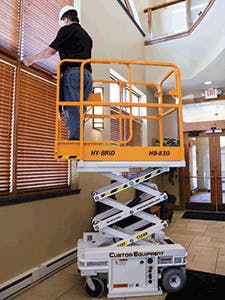Workers often are tempted to make due with available tools and risk bodily injury for the sake of saving time and energy. This temptation applies to nearly all tools and equipment, including those designed to provide access to elevated work heights.
The risk of falls from elevated working heights is very real. According to Liberty Mutual's 2013 Workplace Safety Index, these types of incidents ranked as the fourth-leading cause of workplace injuries, resulting in $4.9 billion in direct costs to businesses.
This is where low-level access lifts come in. These lifts have many features that raise the level of safety on job sites and provide opportunities for safely working at heights that more traditional options might not provide.
Hand-Over-Hand
One of the most common tools, and often the first one that people think of for working at heights, is the ladder. Ladders are quick to set up, are graded for a variety of applications and, since they're fairly inexpensive, are an attractive option. But ladders are not appropriate for every at-height use.
Ladders come in four duty ratings: Type III household, Type II commercial, Type I industrial heavy and Type IA industrial, which can withstand as much as 300 pounds. If that workload is exceeded – for instance, if a worker decides to use a household ladder while installing heavy equipment – the ladder could snap under the combined weight of the worker, tools and materials and cause severe injury.
With low-level lifts, workers can load materials and move the lift and materials from place to place on the jobsite. Some of the lifts are even equipped with overload sensors that alert the user or limit the lift height if there is excess weight on the machine.
Selecting the right height also is critical. If a ladder is too short, it could tempt a worker to ignore safety precautions and stand on the top rungs or overstretch beyond the rails, either of which can lead to a fall. A ladder that's too tall is more likely to be set up incorrectly against a wall, causing it to slip out from underneath a worker because there is not enough friction to hold it in place.
Low-level lifts address these potential pitfalls by offering working heights as high as 20 feet, reaching the exact height that offers the greatest productivity.
But let's say you've selected the right type of ladder for the job. Now there's the challenge of properly setting it up. OSHA recommends that a ladder be one-quarter of the working distance away from a wall. For instance, if you know the wall's height is 40 feet, the base of the ladder should be 10 feet away. To access an elevated surface, OSHA says the top of the ladder should extend three feet higher. In addition, the American National Standards Institute recommends ladders should be set at a 75-degree angle.
It often is impractical to measure for these recommendations on the job site, but not following them can lead to improper setup, substantially reduce the stability of the ladder, and increase the risk of falls. Low-level access lifts are ready to use when they arrive on site, meaning less setup time is needed to ensure a safe ascent.
Juggling Productivity and Safety
If you are working on a ladder, being productive and safe can become a juggling act. When large projects like electrical and HVAC jobs in new buildings require moving the ladder as work progresses, the contractor needs to climb down, fold up the ladder, carry it a few feet over, set it back up correctly and climb up the rungs to start again. This constant moving, climbing and standing on ladder rungs can easily fatigue a worker, which also increases the risk for falls.
By comparison, with a low-level access lift, the contractor simply can use the controls to move the platform up and down. This eliminates the fatigue and reduces the hassle of moving a ladder to a new location. By eliminating daunting climbs and providing a step-in height as low as 20.28 inches, the lifts allow workers to relocate without the hassles of disassembly and reassembly.
An operator also might overreach or "walk" the ladder to avoid moving it, either to save on effort or time. Overreaching shifts the center of gravity from between the ladder rails to either side, which can cause it to shift and topple over.
"Walking" the ladder is just as dangerous. This is when a user tries to alternate the weight from side to side on the rungs to make the ladder "walk" forward. This can cause the ladder to tip on its side or fold up on itself. With low-level access lifts, the user brings the lift to the ground and pushes the unit to the next location. With a self-propelled lift, he simply can drive it.
Side loading also can be a safety concern. When a user standing on a ladder performs work that exerts force against the wall, like drilling or sawing, the ladder can tip due to lack of counterweight. Additionally, if the worker tries to pull up heavy tools or materials from the ladder's side, he actually can pull himself down. Most lifts employ counterweights to address side-loading issues, and some even have tilt sensors that alert the operator when loads become imbalanced.
Scaffolding Safety Concerns
When project managers deem a task too impractical or dangerous for a ladder, they might opt for a scaffolding system. While scaffolds might offer more platform space than ladders, they can be just as dangerous if not used correctly.
According to the U.S. Department of Labor, nearly 65 percent of workers in the construction industry use scaffolding. Scaffolds can provide variable working heights and larger elevated platforms, where ladders cannot. Still, they create some of the same safety challenges.
For instance, scaffolding safety begins with setup. Sections need to be correctly assembled to provide a stable framework, and a worker still needs to pull boards up the side of the scaffold to provide a platform to work on. If a scaffold is improperly assembled, it can collapse underneath the weight of workers, tools and materials.
Unlike scaffolding, low-level scissor lifts come assembled and can be pushed, or in some cases driven, onto hard, level surfaces. Workers save time because they don't have to carry cumbersome poles, bulky deck pieces and tools. Most units are small enough to fit through doorways and into elevators, which eliminates the need to carry scaffolding frames up or down multiple flights of stairs.
Once the scaffolding is in place, you still need to maintain three points of contact while climbing up the sides. This can make hauling tools and materials a dangerous chore. Also, the user has to accomplish the challenge of safely climbing on and off the deck. Like the ladder, the extra climbing can increase user fatigue, which can lead to more slips and falls. On a low-level scissor lift, workers remain on the platform and have no sides to climb or decks to assemble.
Lifts also offer a fully encircled work platform with 38- to 42-inch-tall railings and toeboards. The railings help prevent workers from falling from an elevated lift, while toeboards protect people below from falling tools and materials. For added fall protection, some low-level-access lifts come with lanyard tie-offs. Workers have the option to attach their safety harnesses or lanyards to the tie-off and the system will catch them if they start to fall.
When a scaffold needs to be moved, the worker needs to remove the deck and in some cases, disassemble and reassemble the scaffolding at the new location. When a scaffold is on wheels, a user might try to "surf" an unsecured scaffold over to the new location by pulling on objects, such as overhead pipes and fixtures, around the work area. This takes the operator's focus off of where the scaffold is traveling, and if the wheels encounter an object or an uneven surface, such as a ramp, the scaffold could tip.
On self-propelled lifts, the user can focus more on the wheels' path to avoid obstacles and uneven work surfaces while driving to the next location. Push-around units have automatic locking mechanisms on the wheels to prevent the unsafe surfing practice.
Elevated Decision Making
The International Powered Access Federation recommends that a complete jobsite assessment be completed before a project begins. It should address factors such as how people will gain access to the project, its scope and size, and the overall working environment. Only after they've completed the assessment should contractors and project managers select the right tools and equipment for the job.
When lifts are part of that tool and equipment mix, remember to inspect them daily and before each use. It also is important to have a qualified aerial lift professional perform required annual inspections. Annual inspections keep users safe by addressing any mechanical issues that might arise through normal wear and tear.
By using low-level access lifts rather than ladders and scaffolds, contractors and project managers can continue making gains in both safety and productivity. And they can be confident in knowing the masterpiece is more than the finished project; it's the time and people that have been spared delays and injuries in the process of completing it.
Justin Kissinger is the marketing manager for Custom Equipment Inc. He has been with the family-owned business since 1998 and during that time has gained knowledge from all areas of the company including assembly, engineering, service and sales. Kissinger earned his bachelor's degree in business from the Milwaukee School of Engineering. He can be reached at 262-644-1300 x13 or via email at [email protected].

